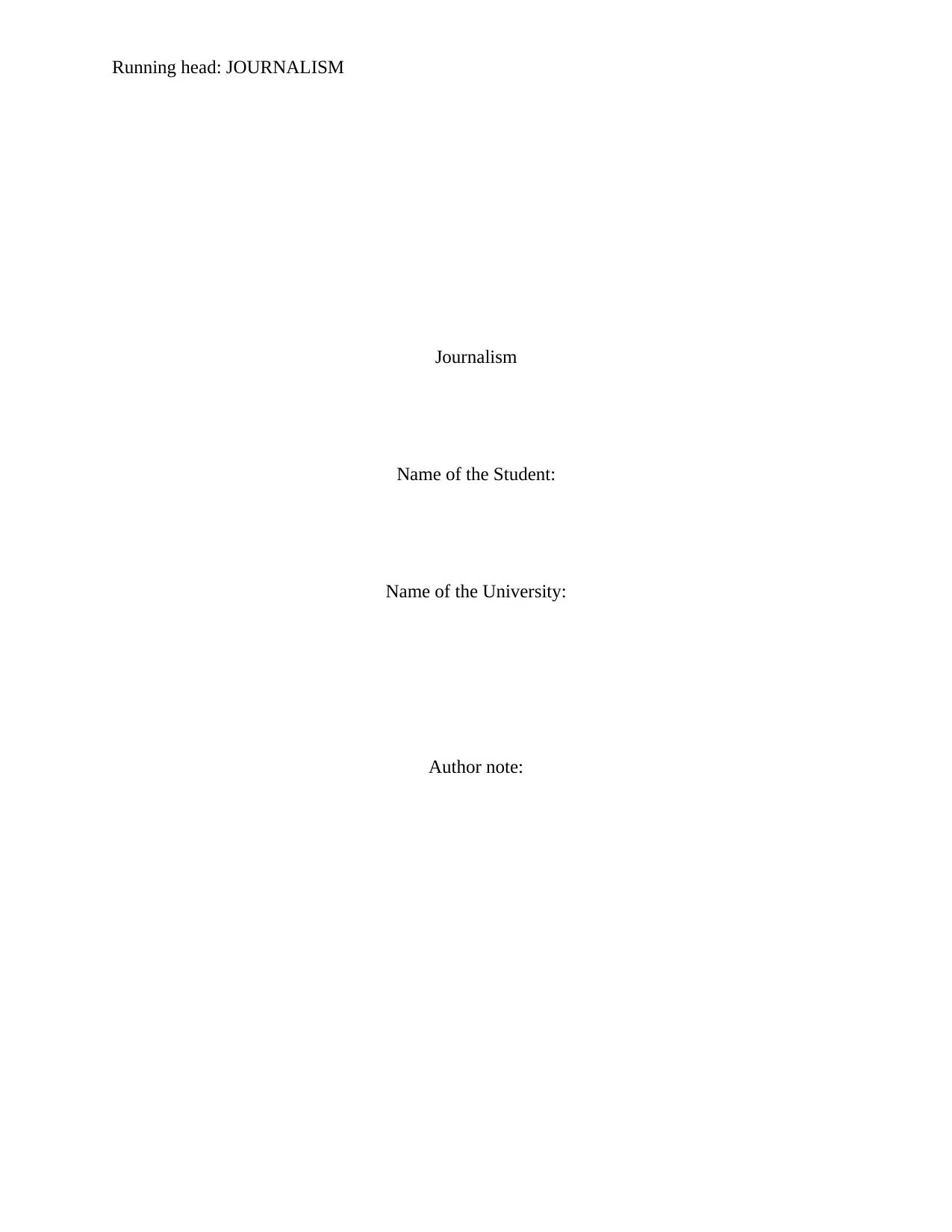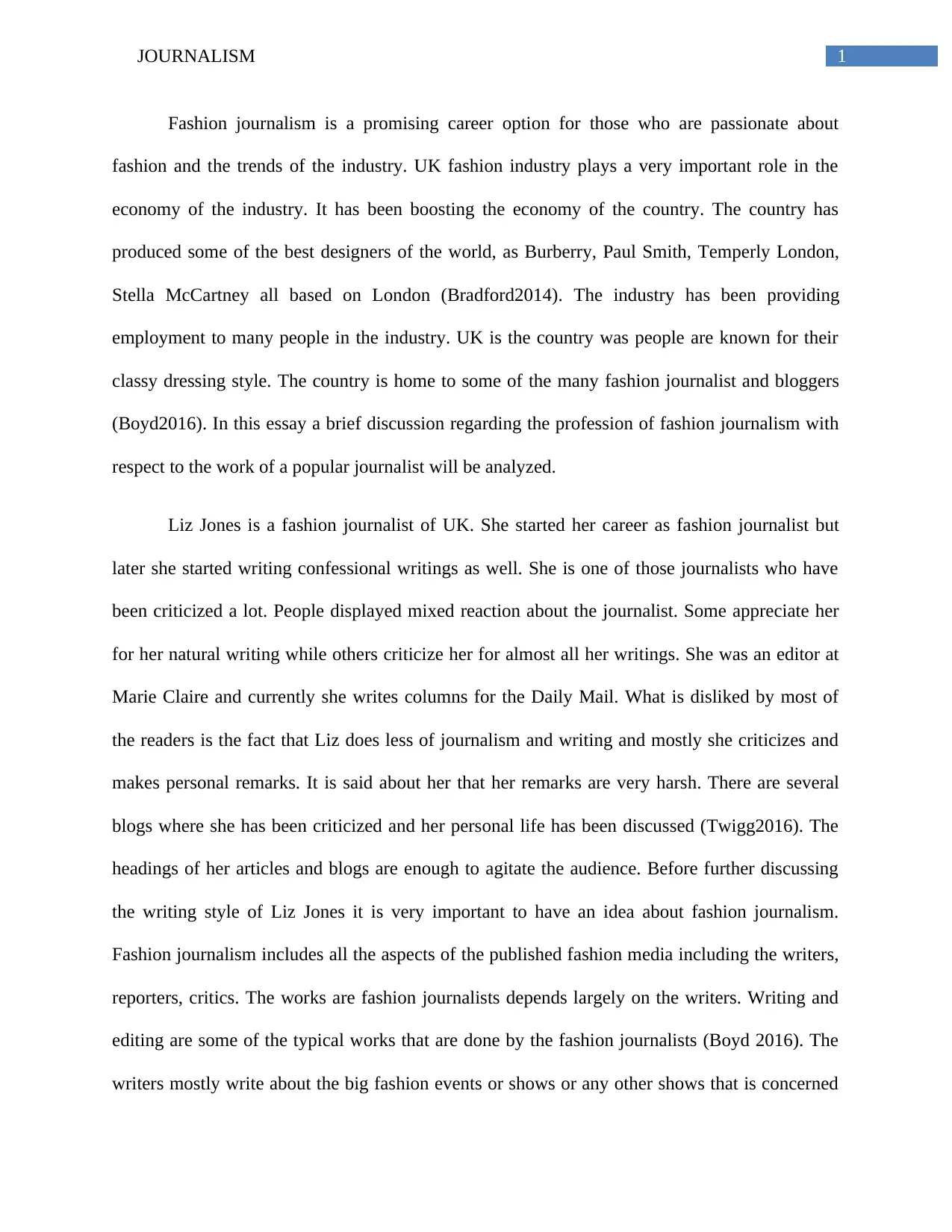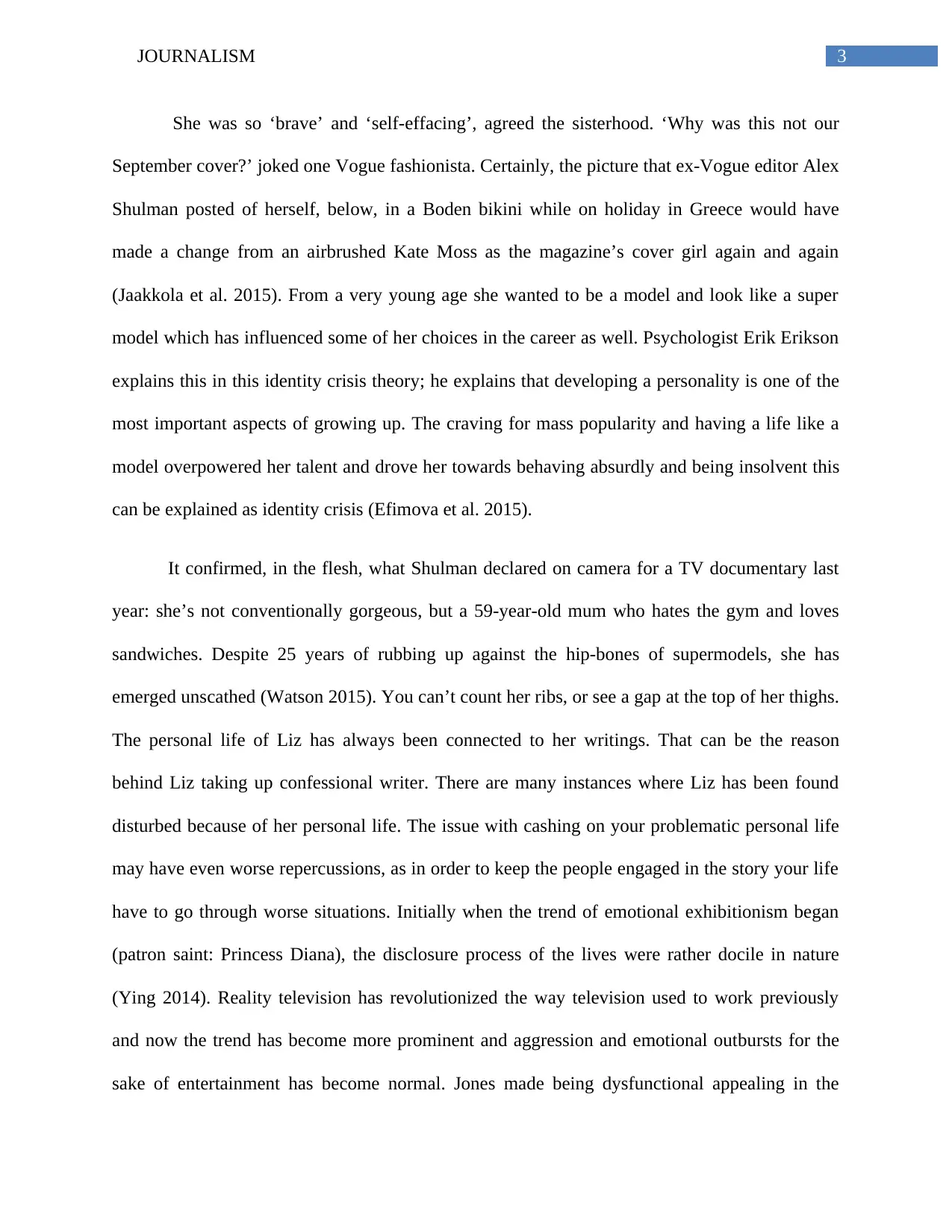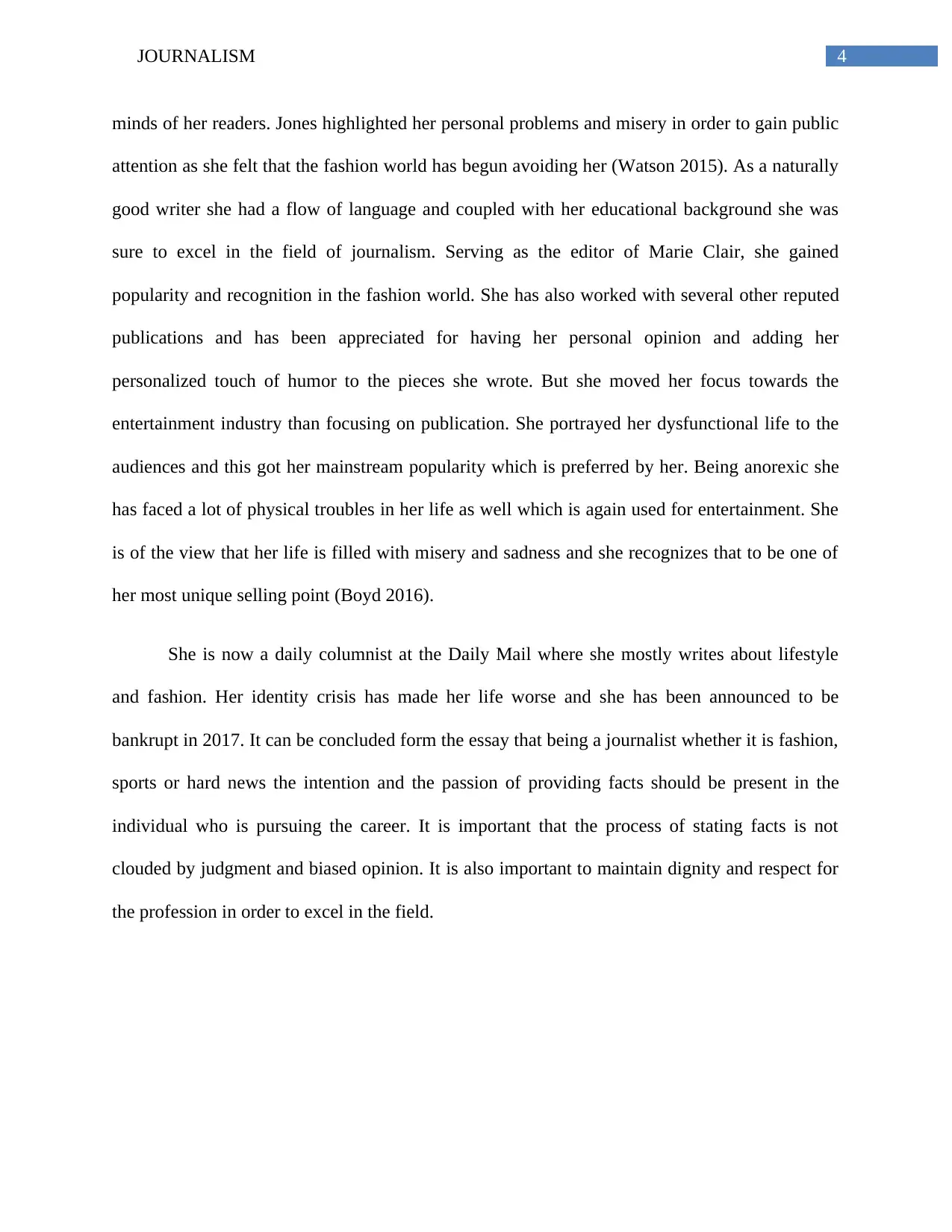A Critical Analysis of Fashion Journalism and Liz Jones's Work
VerifiedAdded on 2020/05/28
|6
|1756
|118
Essay
AI Summary
This essay examines the profession of fashion journalism, using the career of UK journalist Liz Jones as a case study. It explores the role of fashion journalists, their writing styles, and the impact of social media on the industry. The essay discusses Liz Jones's career, her critical reception, and the criticisms she has faced for her personal remarks and lack of traditional journalism. It also touches upon the golden principles of journalism, the influence of personal life on writing, and the ethical considerations within fashion journalism. The essay references various sources to support its analysis and concludes with a reflection on the responsibilities of journalists in the field, emphasizing the importance of factual reporting, unbiased opinions, and professional dignity. The paper highlights the challenges and complexities faced by fashion journalists in the current media landscape.

Running head: JOURNALISM
Journalism
Name of the Student:
Name of the University:
Author note:
Journalism
Name of the Student:
Name of the University:
Author note:
Paraphrase This Document
Need a fresh take? Get an instant paraphrase of this document with our AI Paraphraser

1JOURNALISM
Fashion journalism is a promising career option for those who are passionate about
fashion and the trends of the industry. UK fashion industry plays a very important role in the
economy of the industry. It has been boosting the economy of the country. The country has
produced some of the best designers of the world, as Burberry, Paul Smith, Temperly London,
Stella McCartney all based on London (Bradford2014). The industry has been providing
employment to many people in the industry. UK is the country was people are known for their
classy dressing style. The country is home to some of the many fashion journalist and bloggers
(Boyd2016). In this essay a brief discussion regarding the profession of fashion journalism with
respect to the work of a popular journalist will be analyzed.
Liz Jones is a fashion journalist of UK. She started her career as fashion journalist but
later she started writing confessional writings as well. She is one of those journalists who have
been criticized a lot. People displayed mixed reaction about the journalist. Some appreciate her
for her natural writing while others criticize her for almost all her writings. She was an editor at
Marie Claire and currently she writes columns for the Daily Mail. What is disliked by most of
the readers is the fact that Liz does less of journalism and writing and mostly she criticizes and
makes personal remarks. It is said about her that her remarks are very harsh. There are several
blogs where she has been criticized and her personal life has been discussed (Twigg2016). The
headings of her articles and blogs are enough to agitate the audience. Before further discussing
the writing style of Liz Jones it is very important to have an idea about fashion journalism.
Fashion journalism includes all the aspects of the published fashion media including the writers,
reporters, critics. The works are fashion journalists depends largely on the writers. Writing and
editing are some of the typical works that are done by the fashion journalists (Boyd 2016). The
writers mostly write about the big fashion events or shows or any other shows that is concerned
Fashion journalism is a promising career option for those who are passionate about
fashion and the trends of the industry. UK fashion industry plays a very important role in the
economy of the industry. It has been boosting the economy of the country. The country has
produced some of the best designers of the world, as Burberry, Paul Smith, Temperly London,
Stella McCartney all based on London (Bradford2014). The industry has been providing
employment to many people in the industry. UK is the country was people are known for their
classy dressing style. The country is home to some of the many fashion journalist and bloggers
(Boyd2016). In this essay a brief discussion regarding the profession of fashion journalism with
respect to the work of a popular journalist will be analyzed.
Liz Jones is a fashion journalist of UK. She started her career as fashion journalist but
later she started writing confessional writings as well. She is one of those journalists who have
been criticized a lot. People displayed mixed reaction about the journalist. Some appreciate her
for her natural writing while others criticize her for almost all her writings. She was an editor at
Marie Claire and currently she writes columns for the Daily Mail. What is disliked by most of
the readers is the fact that Liz does less of journalism and writing and mostly she criticizes and
makes personal remarks. It is said about her that her remarks are very harsh. There are several
blogs where she has been criticized and her personal life has been discussed (Twigg2016). The
headings of her articles and blogs are enough to agitate the audience. Before further discussing
the writing style of Liz Jones it is very important to have an idea about fashion journalism.
Fashion journalism includes all the aspects of the published fashion media including the writers,
reporters, critics. The works are fashion journalists depends largely on the writers. Writing and
editing are some of the typical works that are done by the fashion journalists (Boyd 2016). The
writers mostly write about the big fashion events or shows or any other shows that is concerned

2JOURNALISM
with the style icons. Recently with the popularity of social media, a lot of writers, bloggers and
journalists have entered the industry. Most of the journalists at times take up the role of a fashion
critic and not fashion journalist. Liz has been one of those writers. This particular attribute of the
writer has proved detrimental for her as she has been facing a lot criticism. Comparing Liz with
other writers’ one can find that she is not different from them. She is basically similar to the
other writers who prefer to criticize (Twigg2016).
Liz Jones is one of the writers who do less of journalism and more criticism of the
fashion sense of other people. Nothing is peculiar about the style of writing style of Liz Jones.
She very much does what most of the writers in the present day do. As far as journalism is
concerned she is far from reporting the real facts (Bradford2014). The golden principle of
journalism is that the writers are supposed to give less of their personal view unless the writer is
a critic. In most of the writings of Liz she was found giving her personal views rather than
reporting the facts. Her remarks were never constructive. There must be very few admirers of
Liz as she is very unpredictable in her writings. Critics believe that the status of her personal life
can be reflected in the writings. Although it might not be right but it certainly reflects the amount
of hatred readers have for her. Within 24 hours of her putting up an article she starts getting
negative responses which includes mails. It is not that she is hated, there are readers who admire
her for her natural writing and straight forward nature that is reflected in the writings (Thurman
et al. 2016).
It is true that one should not write to please others as it should come from within and Liz
does exactly the same. She does not pretend to praise any fashion trend or style icon if she does
not feel like doing so. This is one positive attribute about Liz. She writes what comes to her mind
naturally (Boyd 2016).
with the style icons. Recently with the popularity of social media, a lot of writers, bloggers and
journalists have entered the industry. Most of the journalists at times take up the role of a fashion
critic and not fashion journalist. Liz has been one of those writers. This particular attribute of the
writer has proved detrimental for her as she has been facing a lot criticism. Comparing Liz with
other writers’ one can find that she is not different from them. She is basically similar to the
other writers who prefer to criticize (Twigg2016).
Liz Jones is one of the writers who do less of journalism and more criticism of the
fashion sense of other people. Nothing is peculiar about the style of writing style of Liz Jones.
She very much does what most of the writers in the present day do. As far as journalism is
concerned she is far from reporting the real facts (Bradford2014). The golden principle of
journalism is that the writers are supposed to give less of their personal view unless the writer is
a critic. In most of the writings of Liz she was found giving her personal views rather than
reporting the facts. Her remarks were never constructive. There must be very few admirers of
Liz as she is very unpredictable in her writings. Critics believe that the status of her personal life
can be reflected in the writings. Although it might not be right but it certainly reflects the amount
of hatred readers have for her. Within 24 hours of her putting up an article she starts getting
negative responses which includes mails. It is not that she is hated, there are readers who admire
her for her natural writing and straight forward nature that is reflected in the writings (Thurman
et al. 2016).
It is true that one should not write to please others as it should come from within and Liz
does exactly the same. She does not pretend to praise any fashion trend or style icon if she does
not feel like doing so. This is one positive attribute about Liz. She writes what comes to her mind
naturally (Boyd 2016).
⊘ This is a preview!⊘
Do you want full access?
Subscribe today to unlock all pages.

Trusted by 1+ million students worldwide

3JOURNALISM
She was so ‘brave’ and ‘self-effacing’, agreed the sisterhood. ‘Why was this not our
September cover?’ joked one Vogue fashionista. Certainly, the picture that ex-Vogue editor Alex
Shulman posted of herself, below, in a Boden bikini while on holiday in Greece would have
made a change from an airbrushed Kate Moss as the magazine’s cover girl again and again
(Jaakkola et al. 2015). From a very young age she wanted to be a model and look like a super
model which has influenced some of her choices in the career as well. Psychologist Erik Erikson
explains this in this identity crisis theory; he explains that developing a personality is one of the
most important aspects of growing up. The craving for mass popularity and having a life like a
model overpowered her talent and drove her towards behaving absurdly and being insolvent this
can be explained as identity crisis (Efimova et al. 2015).
It confirmed, in the flesh, what Shulman declared on camera for a TV documentary last
year: she’s not conventionally gorgeous, but a 59-year-old mum who hates the gym and loves
sandwiches. Despite 25 years of rubbing up against the hip-bones of supermodels, she has
emerged unscathed (Watson 2015). You can’t count her ribs, or see a gap at the top of her thighs.
The personal life of Liz has always been connected to her writings. That can be the reason
behind Liz taking up confessional writer. There are many instances where Liz has been found
disturbed because of her personal life. The issue with cashing on your problematic personal life
may have even worse repercussions, as in order to keep the people engaged in the story your life
have to go through worse situations. Initially when the trend of emotional exhibitionism began
(patron saint: Princess Diana), the disclosure process of the lives were rather docile in nature
(Ying 2014). Reality television has revolutionized the way television used to work previously
and now the trend has become more prominent and aggression and emotional outbursts for the
sake of entertainment has become normal. Jones made being dysfunctional appealing in the
She was so ‘brave’ and ‘self-effacing’, agreed the sisterhood. ‘Why was this not our
September cover?’ joked one Vogue fashionista. Certainly, the picture that ex-Vogue editor Alex
Shulman posted of herself, below, in a Boden bikini while on holiday in Greece would have
made a change from an airbrushed Kate Moss as the magazine’s cover girl again and again
(Jaakkola et al. 2015). From a very young age she wanted to be a model and look like a super
model which has influenced some of her choices in the career as well. Psychologist Erik Erikson
explains this in this identity crisis theory; he explains that developing a personality is one of the
most important aspects of growing up. The craving for mass popularity and having a life like a
model overpowered her talent and drove her towards behaving absurdly and being insolvent this
can be explained as identity crisis (Efimova et al. 2015).
It confirmed, in the flesh, what Shulman declared on camera for a TV documentary last
year: she’s not conventionally gorgeous, but a 59-year-old mum who hates the gym and loves
sandwiches. Despite 25 years of rubbing up against the hip-bones of supermodels, she has
emerged unscathed (Watson 2015). You can’t count her ribs, or see a gap at the top of her thighs.
The personal life of Liz has always been connected to her writings. That can be the reason
behind Liz taking up confessional writer. There are many instances where Liz has been found
disturbed because of her personal life. The issue with cashing on your problematic personal life
may have even worse repercussions, as in order to keep the people engaged in the story your life
have to go through worse situations. Initially when the trend of emotional exhibitionism began
(patron saint: Princess Diana), the disclosure process of the lives were rather docile in nature
(Ying 2014). Reality television has revolutionized the way television used to work previously
and now the trend has become more prominent and aggression and emotional outbursts for the
sake of entertainment has become normal. Jones made being dysfunctional appealing in the
Paraphrase This Document
Need a fresh take? Get an instant paraphrase of this document with our AI Paraphraser

4JOURNALISM
minds of her readers. Jones highlighted her personal problems and misery in order to gain public
attention as she felt that the fashion world has begun avoiding her (Watson 2015). As a naturally
good writer she had a flow of language and coupled with her educational background she was
sure to excel in the field of journalism. Serving as the editor of Marie Clair, she gained
popularity and recognition in the fashion world. She has also worked with several other reputed
publications and has been appreciated for having her personal opinion and adding her
personalized touch of humor to the pieces she wrote. But she moved her focus towards the
entertainment industry than focusing on publication. She portrayed her dysfunctional life to the
audiences and this got her mainstream popularity which is preferred by her. Being anorexic she
has faced a lot of physical troubles in her life as well which is again used for entertainment. She
is of the view that her life is filled with misery and sadness and she recognizes that to be one of
her most unique selling point (Boyd 2016).
She is now a daily columnist at the Daily Mail where she mostly writes about lifestyle
and fashion. Her identity crisis has made her life worse and she has been announced to be
bankrupt in 2017. It can be concluded form the essay that being a journalist whether it is fashion,
sports or hard news the intention and the passion of providing facts should be present in the
individual who is pursuing the career. It is important that the process of stating facts is not
clouded by judgment and biased opinion. It is also important to maintain dignity and respect for
the profession in order to excel in the field.
minds of her readers. Jones highlighted her personal problems and misery in order to gain public
attention as she felt that the fashion world has begun avoiding her (Watson 2015). As a naturally
good writer she had a flow of language and coupled with her educational background she was
sure to excel in the field of journalism. Serving as the editor of Marie Clair, she gained
popularity and recognition in the fashion world. She has also worked with several other reputed
publications and has been appreciated for having her personal opinion and adding her
personalized touch of humor to the pieces she wrote. But she moved her focus towards the
entertainment industry than focusing on publication. She portrayed her dysfunctional life to the
audiences and this got her mainstream popularity which is preferred by her. Being anorexic she
has faced a lot of physical troubles in her life as well which is again used for entertainment. She
is of the view that her life is filled with misery and sadness and she recognizes that to be one of
her most unique selling point (Boyd 2016).
She is now a daily columnist at the Daily Mail where she mostly writes about lifestyle
and fashion. Her identity crisis has made her life worse and she has been announced to be
bankrupt in 2017. It can be concluded form the essay that being a journalist whether it is fashion,
sports or hard news the intention and the passion of providing facts should be present in the
individual who is pursuing the career. It is important that the process of stating facts is not
clouded by judgment and biased opinion. It is also important to maintain dignity and respect for
the profession in order to excel in the field.

5JOURNALISM
References
Boyd, K.C., 2016. A Multimedia Analysis of the Diversification of Fashion Journalism.
Bradford, J., 2014. Fashion journalism. Routledge.
Efimova, O.I., Salakhova, V.B., Mikhaylova, I.V., Gnedova, S.B., Chertushkina, T.A. and
Agadzhanova, E.R., 2015. Theoretical review of scientific approaches to understanding crisis
psychology. Mediterranean Journal of Social Sciences, 6(2 S3), p.241.
Jaakkola, M., Hellman, H., Koljonen, K. and Väliverronen, J., 2015. Liquid modern journalism
with a difference: The changing professional ethos of cultural journalism. Journalism
Practice, 9(6), pp.811-828.
Thurman, N., Cornia, A. and Kunert, J., 2016. Journalists in the UK. Reuters Institute for the
Study of Journalism.
Twigg, J., 2016. Fashion, the media and age: How women’s magazines use fashion to negotiate
age identities. European Journal of Cultural Studies, p.1367549417708432.
Watson, C., 2015. Law and ethics in fashion journalism.
Ying, M.E.N.G., 2014. Interaction of Media Development and Information Productivity. Journal
of Fujian Normal University (Philosophy and Social Sciences Edition), 6, p.021.
References
Boyd, K.C., 2016. A Multimedia Analysis of the Diversification of Fashion Journalism.
Bradford, J., 2014. Fashion journalism. Routledge.
Efimova, O.I., Salakhova, V.B., Mikhaylova, I.V., Gnedova, S.B., Chertushkina, T.A. and
Agadzhanova, E.R., 2015. Theoretical review of scientific approaches to understanding crisis
psychology. Mediterranean Journal of Social Sciences, 6(2 S3), p.241.
Jaakkola, M., Hellman, H., Koljonen, K. and Väliverronen, J., 2015. Liquid modern journalism
with a difference: The changing professional ethos of cultural journalism. Journalism
Practice, 9(6), pp.811-828.
Thurman, N., Cornia, A. and Kunert, J., 2016. Journalists in the UK. Reuters Institute for the
Study of Journalism.
Twigg, J., 2016. Fashion, the media and age: How women’s magazines use fashion to negotiate
age identities. European Journal of Cultural Studies, p.1367549417708432.
Watson, C., 2015. Law and ethics in fashion journalism.
Ying, M.E.N.G., 2014. Interaction of Media Development and Information Productivity. Journal
of Fujian Normal University (Philosophy and Social Sciences Edition), 6, p.021.
⊘ This is a preview!⊘
Do you want full access?
Subscribe today to unlock all pages.

Trusted by 1+ million students worldwide
1 out of 6
Related Documents
Your All-in-One AI-Powered Toolkit for Academic Success.
+13062052269
info@desklib.com
Available 24*7 on WhatsApp / Email
![[object Object]](/_next/static/media/star-bottom.7253800d.svg)
Unlock your academic potential
Copyright © 2020–2025 A2Z Services. All Rights Reserved. Developed and managed by ZUCOL.




